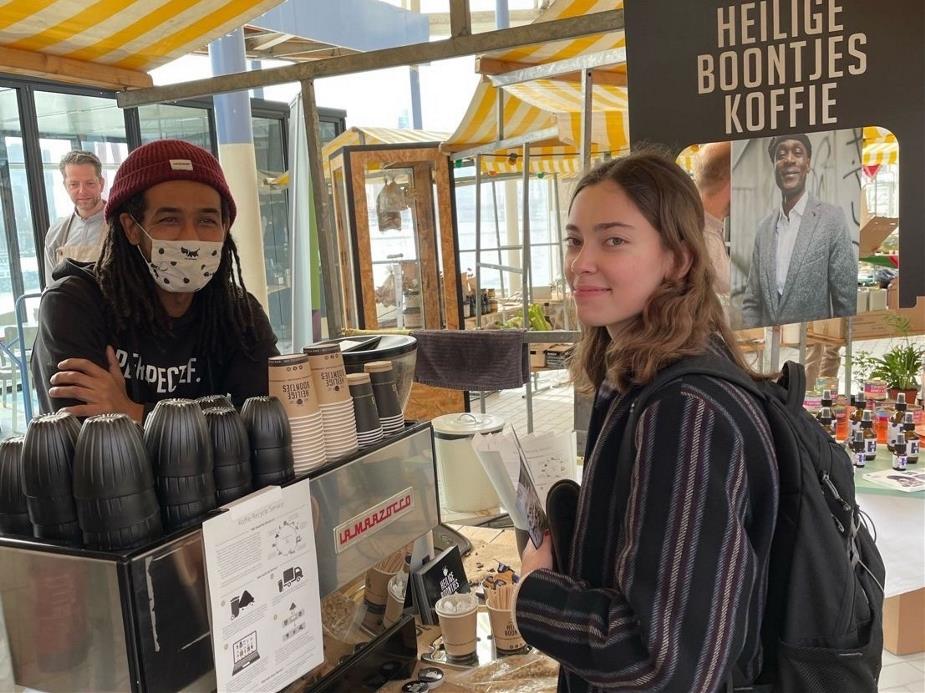Turning coffee waste into coffee containers

What if we could ‘close the loop’ of every product’s life cycle by reusing its waste? As part of her graduation project, Industrial Design Engineering student Celina Whitehead did an internship with Coffee Based, a company that strives to design zero-waste innovations by applying spent coffee grounds as resources. Celina looked into new material possibilities the company could use, and designed a storage container for coffee beans and coffee waste, made from coffee grounds. ‘My interest in circular and social design and sustainability drew me to this company.’
Swimming paradise turned into circular paradise
On finding a graduation project, Celina says: ‘I did a lot of online research into sustainable companies that develop bioplastics, develop resource-efficient strategies and create sustainable products for reuse.’ During class, she met a client who worked with seaweed at BlueCity, a platform for circular entrepreneurs based in the former tropical swimming paradise Tropicana in Rotterdam. The pool's water slides and decorative rock formations are still prominently featured in the building. Intrigued, Celina looked into the different companies at the circular paradise and came across Coffee Based.
Coffee Based aims to close the loop by designing out waste and preserving the value of the material (the used coffee grounds). They do this by developing three types of materials out of bioplastics made from the spent coffee grounds. They then use these materials to create a variety of products, like coffee cups, notebooks, and plant pots. ‘Finding value in the raw material’s authentic colour, smell, and other valuable elements, the company uses the material with the aim to develop greater innovations and eventually eliminate waste entirely.’
Celina's activities
Celina initially did material exploration research for the reuse of spent coffee grounds and/or coffee by-products that occur in the coffee process. She put a lot of time and effort into this research, and even consulted experts who had implemented different types of coffee-based materials that might be interesting for the company to develop. Through her research, Celina says, she ‘found that the new material would be hindered by feasibility barriers’; it was a novelty product and therefore raised viability concerns.
While Celina was disappointed at first, she recognised that this was not a waste of research, as a negative conclusion is still a conclusion. ‘I realised that I had provided the company with valuable material explorations, and had given them insights into what exists and can still be developed, and which options are not yet possible.’ Aside from this material research, Celina also worked on another project, namely the designing of a product to use in service: a coffee container made from coffee waste.
It is a coffee-based product for service in the coffee industry
This coffee container made from coffee waste was designed to provide coffee suppliers a way of reusing their own waste. ‘It is a coffee-based product for service in the coffee industry.’ The container Celina and her team designed can be used in collecting, storing and transporting coffee beans and coffee waste. Unlike the current general use of virgin plastic containers, this container aims for a closed-loop service: the container – made from coffee waste – is used to both distribute coffee beans to suppliers, and to collect their coffee waste for recycling.
Looking back and to the future
Over the past five months, Celina has learned a lot. ‘I have applied real product design which goes beyond just the design, and also considers the viability of the project with the stakeholders and the feasibility for manufacturing.’ She most enjoyed the weeks of research in which she discovered various potential opportunities for the waste material. ‘As a designer, I see myself as a design researcher, a conceptual artist and a strategic designer.’ All in all, the internship helped her gain a lot of professional experience that came with working on an individual project.
Aside from the internship, Celina has also been working as a part-time research assistant for Mission Zero and Laura Stevens and is involved in her biomimetic research. ‘Through this I also really discovered my passion to combine research, writing and design in my future career.’ For Celina, ‘the past few months have confirmed my sweet spot model, my choices for a research-based master – Industrial Design at the Royal Academy of Art – and my aspirations to continue my career in the field of systems and service design research.’
Read more about Laura Stevens and her research.
Read more about the Industrial Design Engineering programme at The Hague University of Applied Sciences.